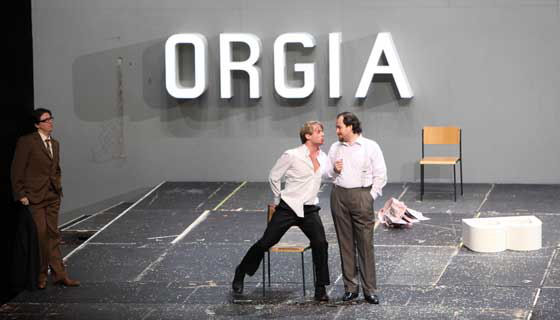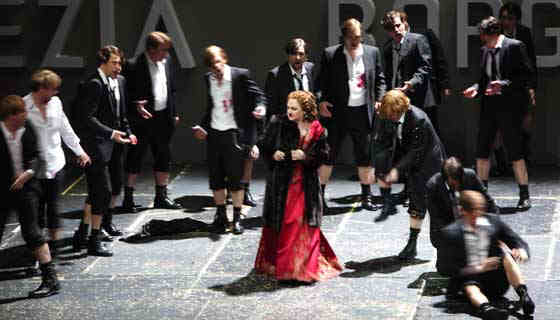Other Links
Editorial Board
-
Editor - Bill Kenny
-
Deputy Editor - Bob Briggs
Founder - Len Mullenger
Google Site Search
SEEN
AND HEARD INTERNATIONAL OPERA REVIEW
Donizetti,
Lucrezia Borgia:
Soloists, Bavarian State Opera Orchestra and Choir,
Bertran de Billy (conductor), Bavarian State Opera
Nationaltheater, Munich 23.2.2009 (JFL)
Production Team:
Christof Loy (direction)
Henrik Ahr (set)
Barbara Dosihn (costumes)
Joachim Klein (lighting)
Andrés Máspero (chorus)
Cast:
The real draw is solely the achievement of the soprano in the title
role for whom the opera’s vocal high-wire act the opera is one
massive vehicle. Everyone in the audience waits through the entire
second act for the very last five minutes (taking Orsini’s “Il
segreto per esse felice” in the passing) when Madamma Borgia has her
gratuitous vocal coloratura moment where the singer—given sufficient
ability—has the opportunity to burn off a display of fireworks that
seems nearly superhuman. The inevitable roaring approval from voice
fetishists - usually from the second tier upward) - make the
impression of an old fashioned freak-show, albeit in a fancy
setting, inevitable.
Edita Gruberova (Lucrezia Borgia)
Pavol Breslik (Gennaro)
Alice Coote (Maffio Orsini)
Franco Vassallo (Don Alfonso)
Steven Humes (Gubetta)
Bruno Ribeiro (Jeppo Liverotto)
Christian Rieger (Don Aposto Gazella)
Emanuele D’Aguanno (Rustighello)
Erik Årman (Oloferno Vitellozzo)
Christopher Magiera (Ascanio Petrucci)
Christian Van Horn (Astolfo)

The opera features a particularly unbelievable story based on
unlikely premises which steer the protagonists into artificially
dramatic situations that bear the least possible resemblance to
reality. As per usual with Italian opera of the time, a series of
unfortunate events/conspiracies/oaths leaves the dramatis personae
in life-and-death scenarios where one or more of them die only to
turn out to have been the murderer’s daughter/son/lover. If you’ve
seen one, you’ve seen them all. Rigoletto and Il Trovatore,
as slightly more sophisticated examples of the same idea, send their
regards.
Of course operas like Lucrezia Borgia are not popular for the
inane story linews that make the average MacGyver plot look new and
sophisticated. Nor is the repetitive music, worthy of a third rate
Sicilian Oompah band, the draw either. For one, every scene takes
three times longer than necessary because everything has to be
spelled and trice repeated with Donizetti unwilling or unable to
express any emotion in music. He has but three modes: regular,
powerful (loud), and ‘ominous’ (fast string tremolos): it’s like
painting with just three colors. Schubert
can put the world's emotion in one tiny song... Donizetti, working
at the rate of Lucrezia, couldn't put four emotions into an
opera the length of Parsifal. Being premiered just six years
before Verdi’s Oberto, it’s no coincidence that the music of
Lucrezia sounds like very early (and very bad) Verdi.

The Bavarian State Opera has Edita Gruberova for the title role, who
is worshiped in the few towns—Munich, Vienna, Zurich— where she
regularly performs. The primadonna assoluta is still a bel
canto monster at almost 63. Although the soft hue of her voice is
worn down a bit, exposing a touch of harshness, she still indulges
in all the highest pianissimo notes she cares to, letting them swell
to a piercing forte with ease.
The direction of Munich’s Lucrezia is by Christof Loy, who
was named Director of the Year 2008 by the German magazine
Opernwelt and is a frequent collaborator of Gruberova’s. His
staging—or lack thereof—strips the opera of anything resembling a
set. A raked floor and a bright white backdrop with neon-letters
spelling out “Lucrezia Borgia” (Gennaro rips the “B” out, when he
assaults the Borgia’s coat of arms: “Oh diamin! ORGIA!”) is all
there is, apart from a few chairs. Why Loy makes Gruberova take her
wig off again (she does so to great effect in his Munich
Roberto Devereux) isn’t quite clear. Her three costumes could,
with some generosity, be construed as the multiple personalities
that live within Lucrezia. The audience booed—as is good tradition,
but the minimalist approach struck as refreshingly uncluttered.
The chorus, Gennaro, and his five friends all run around in Pulp
Fiction uniform: black suites and narrow black ties. Only the
ruffians in Act II look as if they had been chased through the
costume magazine with the mission to pick whichever corniest 1950s
Verdi costume first caught their eye. The ill fitting tights in
every garish color and bad wigs were probably a clever
self-referential joke of the production team, but that joke not
being shared with the viewer, it just looked dumb. Zestfully
throwing plastic wine glasses about, only for them to bounce off the
floor with a hollow thud, is an embarrassment worthy of high-school
productions that I thought would never happen at the Munich Opera.
Pavol Breslik as Gennaro and Alice Coote as Maffio Orsini made the
most of their duty to pass the time between Gruberova outbreaks.
Their tender duet—two men acting like a loving couple, played by a
man and a woman—was a dramatic highpoint. Franco Vassallo’s smooth
bass mastered Don Alfonso’s part agreeably. Loy’s team consists of
lighting designer Joachim Klein, Barbara Drosihn who is in charge of
costumes, and Henrik Ahr, responsible for the set. Bertrand de
Billy’s conducting didn’t go beyond supporting and cuing the
singers, but then he had nothing to work with, musically.
Pictures ©
Wilfried Hoesl
Back
to Top
Cumulative Index Page
